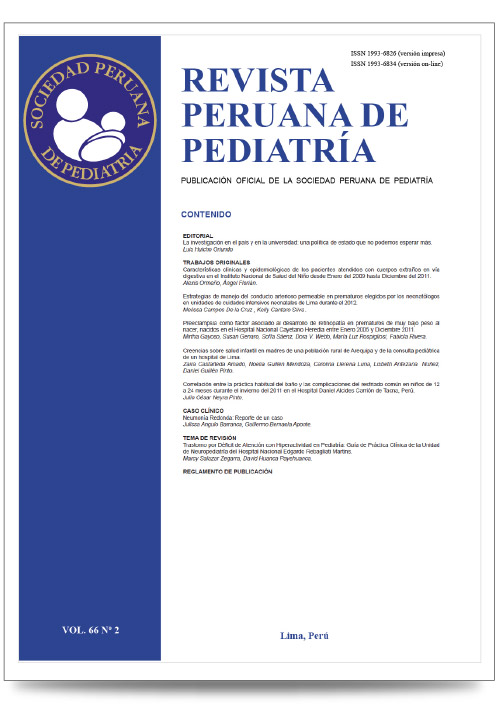Clinical and epidemiological characteristics of patients seen with foreign bodies in the digestive tract at the Instituto Nacional de Salud del Niño from January 2009 through December 2011
DOI:
https://doi.org/10.61651/rped.2013v66n2p51-61Keywords:
Foreign Bodies, Endoscopy, Gastrointestinal, ChildAbstract
Introduction: The ingestion of foreign bodies (FB) is more and more frequently reported in medical practice, constituting the second indication of upper endoscopy in pediatric emergency after gastrointestinal bleeding.
Objective: To describe the clinical and epidemiological characteristics of patients treated with EC in the digestive tract at the Instituto Nacional de Salud del Niño from January 2009 to December 2011.
Methods: We reviewed the medical records of 148 patients with CE in digestive tract treated between January 1, 2009 and December 31, 2011 at the Instituto Nacional de Salud del Niño who met the inclusion criteria. For statistical analysis we used SPSS (Statistical Package for Social Sciences) v. 19 for Windows.
Results: The age group most affected was from 6 months to 3 years, with a slight male predominance. In 16.9% of cases were reported prior extraction maneuvers without success and in 75.7% of cases the extraction was performed after 24 hours. Most frequently reported vomiting, drooling and dysphagia when the FB lodged in the esophagus. The endoscopic removal was performed in 76.4% of cases and FB most frequently found were coins and disc batteries. Complications occurred in 29.1%, being more frequent ulcers and erosions in the gastrointestinal mucosa. Hospitalization was required in 16.2% of patients.
Conclusions: The most frequently affected age group was 6 months to 3 years, endoscopic removal was performed in most patients, CE most commonly ingested was coins and the most frequent location was the upper esophagus. The most frequent complications were ulcers and erosions in the gastrointestinal mucosa.
Downloads
Downloads
Published
How to Cite
Issue
Section
Categories
License

This work is licensed under a Creative Commons Attribution 4.0 International License.
Authors will retain the copyright and grant the right to publish their work in the journal while allowing third parties to share it under the Creative Commons Attribution license.
Articles are published under a Creative Commons license that allows sharing and adaptation with appropriate credit. CC BY 4.0 license. Available in English at https://creativecommons.org/licenses/by/4.0/
Authors may use other information disclosure formats as long as the initial publication in the journal is cited. The dissemination of the work through the Internet is recommended to increase citations and promote academic exchanges.
The published content does not necessarily reflect the specific point of view of the journal, and the authors assume full responsibility for the content of their article.




